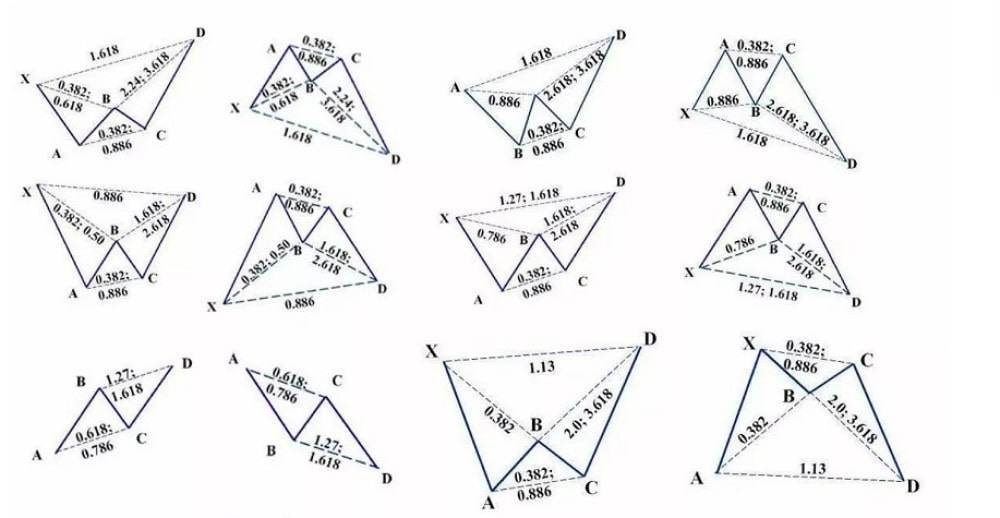Harmonic trading is a technical analysis approach that seeks to identify recurring price patterns in financial markets. The approach is based on the premise that markets are governed by patterns and geometry, and that price movements tend to follow specific ratios and proportions.
The foundation of harmonic trading is the concept of Fibonacci ratios, which are derived from the Fibonacci sequence. The most commonly used Fibonacci ratios in harmonic trading are 0.382, 0.500, 0.618, 0.786, and 1.272.
Harmonic traders look for specific price patterns that reflect these ratios and proportions. These patterns are often referred to as "harmonic patterns," and they include the Gartley pattern, the Bat pattern, the Butterfly pattern, and the Crab pattern, among others. These patterns are named after animals because they resemble the shape of these creatures.
To trade using harmonic patterns, traders typically look for specific points in the pattern where they can enter or exit a trade, based on the likelihood of a price reversal. These points are often called "price action zones" and are derived from the Fibonacci ratios and other technical indicators.
Harmonic trading requires a significant amount of chart analysis and technical skills. It is often used in conjunction with other technical analysis approaches, such as support and resistance levels, trend lines, and moving averages. Traders who use harmonic trading often have a deep understanding of price action and market psychology, as well as a willingness to be patient and wait for the right set-up to present itself.

Harmonic trading is a relatively advanced trading strategy that requires a deep understanding of technical analysis and chart patterns. The approach is based on the idea that markets move in waves, and that these waves can be mapped out using Fibonacci ratios and other technical indicators.
One of the key principles of harmonic trading is the idea of symmetry. Harmonic patterns are symmetrical in nature, which means that the ratio of one price movement to another is often the same as the ratio of other price movements within the pattern. For example, if the price movement from A to B is 1.618 times the size of the price movement from X to A, then the price movement from B to C should be 1.618 times the size of the price movement from A to B.
There are several different types of harmonic patterns that traders can use to identify potential trade opportunities. Some of the most commonly used patterns include the Gartley pattern, the Butterfly pattern, and the Crab pattern. Each pattern has a specific set of rules for identifying the key price levels and ratios that are used to trade the pattern.
Harmonic trading can be used in any financial market, including stocks, commodities, and forex. It is often used in conjunction with other technical analysis tools, such as moving averages, trend lines, and support and resistance levels. Traders who use harmonic trading typically have a strong understanding of chart patterns and technical analysis, as well as a willingness to be patient and wait for the right set-up to present itself.
Overall, harmonic trading is a complex and advanced trading strategy that requires a significant amount of skill and experience to use effectively. It can be a powerful tool for identifying potential trade opportunities and managing risk, but it should be used in conjunction with other technical analysis tools and risk management strategies to maximize its effectiveness.
Harmonic trading has become increasingly popular in recent years, with many traders using the approach to identify potential trade opportunities in the financial markets. Here are a few notable traders who are known to use harmonic trading in their trading strategies:
-
Scott Carney - Scott Carney is considered to be one of the pioneers of harmonic trading. He is the author of several books on the subject, including "Harmonic Trading: Volume 1" and "Harmonic Trading: Volume 2." Carney has also developed several proprietary harmonic trading patterns, including the "Crab" and the "Shark."
-
Larry Pesavento - Larry Pesavento is a veteran trader and author who has been using harmonic trading since the 1980s. He is the author of several books on technical analysis, including "Fibonacci Ratios with Pattern Recognition" and "Trade What You See: How to Profit from Pattern Recognition."
-
Scott M. Phillips - Scott M. Phillips is a professional trader and author who uses harmonic trading to identify potential trade opportunities in the markets. He is the author of "Trading Strategies for the Forex Market" and "The Complete Guide to Technical Analysis for the Futures Markets: Fundamental Analysis, Volume 2."
-
Dan Gramza - Dan Gramza is a professional trader and author who uses harmonic trading as part of his overall trading strategy. He is the author of "Trading in the Eye of the Storm" and "Mastering Market Analysis."
-
Ross Beck - Ross Beck is a professional trader and educator who uses harmonic trading as part of his trading approach. He is the author of "The Gartley Trading Method: New Techniques to Profit from the Markets Most Powerful Formation."
These are just a few of the many traders who use harmonic trading as part of their trading strategies. Harmonic trading can be an effective way to identify potential trade opportunities in the markets, but it requires a significant amount of skill and experience to use effectively.

